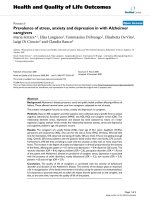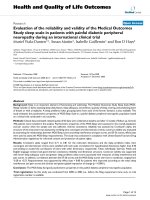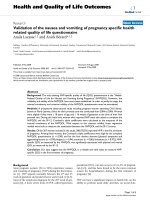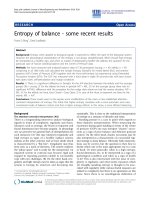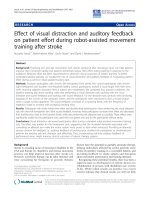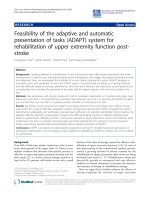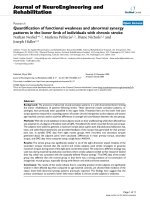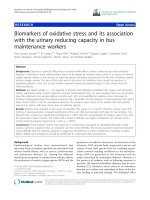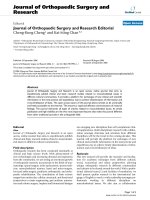Báo cáo hóa học: "Department of Electrical Electronic and Computer " pptx
Bạn đang xem bản rút gọn của tài liệu. Xem và tải ngay bản đầy đủ của tài liệu tại đây (729.07 KB, 3 trang )
EURASIP Journal on Applied Signal Processing 2004:16, 2397–2399
c
2004 Hindawi Publishing Corporation
Editorial
Giovanni L. Sicuranza
Department of Electrical Electronic and Computer Engineering (DEEI), University of Trieste, 34127 Trieste, Italy
Email:
Gonzalo Arce
Department of Electrical and Computer Engineeri ng, University of Delaware, Newark, DE 19716-3130, USA
Email:
Moncef Gabbouj
Institute of Signal Processing, Tampere University of Technology, 33101 Tampere, Finland
Email: moncef.gabbouj@tut.fi
Stephen Marshall
Department of Electronic and Electrical Engineering, University of Strathclyde, 204 George Street, Glasgow G1 1XW, Scotland
Email:
This second special issue on nonlinear signal and image pro-
cessing includes another group of high-quality papers se-
lected among the more than 60 submissions received in re-
sponse to the EURASIP JASP call for papers.
The high number of submissions testifies for the vitality
of the field and the great interest existing in the signal pro-
cessing community for nonlinear theories and tools.
The special issue features 18 papers mainly related to
the solution of classical problems in the area of nonlinear
image and video processing such as noise suppression and
image restoration. In addition, contributions in the field of
communications together with other interesting applications
are considered. The wide range of topics dealt with clearly
demonstrates the ubiquitous role played by nonlinear tech-
niques in signal processing tasks.
Thefirstgroupofpapersdealswithmodelsandtech-
niques for noise estimation and suppression from images.
The estimation of the standard deviation of noise con-
taminating an image is a fundamental step in wavelet-based
noise reduction techniques. In the paper authored by A. De
Stefano et al. three novel and alternative methods for estimat-
ing the noise standard deviation are proposed and compared
with the MAD method.
Using notions from robust statistics, a variational filter
referred to as a Huber gradient descent flow is proposed
by A. Ben Hamza et al. It is a result of optimizing a Hu-
ber functional subject to some noise constraints, and takes
a hybrid form of a total variation diffusion for large gradi-
ent magnitudes and of a linear diffusion for small gradient
magnitudes.
Achieving a good performance in the suppression of
impulsive noise is usually at the expense of blurred and
distorted image features. One way to avoid this problem
is to include a decision-making component in the filter-
ing structure based on effective impulse detection mecha-
nism. The function of the detection mechanism is to check
each pixel to detect w hether it is distorted or not, and
then apply nonlinear filtering only on distorted pixels. E.
Bes¸dok proposes an impulse noise removal filter based on
an adaptive neuro-fuzzy inference system. The proposed fil-
ter comprises three main steps: finding the pixels that are
suspected to be corrupted, carrying out Delaunay trian-
gulation, and finally, making estimation for intensity val-
ues of corrupted pixels within each of the Delaunay trian-
gles.
P. C¸ivicio
˘
glu et al. present in their paper an impulsive
noise exclusive filter. For the impulse detection mechanism,
the filter uses chi-square goodness-of-fit test-based statis-
tic.
The following three papers cover different aspects of non-
linear methods for image restoration and deblurring.
In the first one, K. Ichou et al. propose a nonlinear
image restoration method based on the generalized radial
basis function network to estimate the nonlinear blurring
2398 EURASIP Journal on Applied Signal Processing
function. A regularization method is also proposed and used
to recover the original image from the nonlinearly degraded
image and a cost function is then minimized using the steep-
est descent technique.
In their paper, M. E. Y
¨
uksel et al. present a new oper-
ator for the restoration of digital images corrupted by im-
pulse noise. The proposed operator for efficient restoration
of digital images corrupted by impulsive noise is a hybrid fil-
ter constructed by combining a recursive switching median
filter with a simple neuro-fuzzy network functioning as an
impulse detector.
The work presented by S. Colonnese et al. addresses the
problem of blind image deblurring, that is, of recovering an
original image observed through one or more unknown lin-
ear channels and corrupted by additive noise. They resort to
an iterative algorithm, belonging to the class of Bussgang al-
gorithms, based on alternating a linear and a nonlinear image
estimation stage.
A couple of papers are related to speckled imagery.
The paper presented by A. C. Frery et al. deals with nu-
merical problems arising when performing maximum likeli-
hood parameter estimation in speckled imagery using small
samples.
A novel approach to reduce speckle noise and enhance
structures in speckle-corrupted images is proposed by Z.
Yang and M. D. Fox. A median-anisotropic diffusion com-
pound scheme is proposed, where the median-filter-based
reaction term acts as a guided energy source to boost the
structures in the underlying image.
The next two papers deal with problems encountered in
the area of pattern recognition.
In their contribution, T. G
´
eraud and J B. Mouret pro-
pose a technique for the extraction of curvilinear objects in
images. The devised application is the recognition of road
networks in satellite imagery. The proposed algorithm is
based on four steps; first, a “potential” domain in which
road-like structures are more evident is chosen; then, mor-
phological operators are applied to obtain a watershed repre-
sentation, and a curve adjacency graph is built. The problem
at this step is one of graph labelling, and it is solved based on
a Markov model and simulated annealing.
In pattern recognition problems, different types of prior
knowledge are encountered. It is important to incorporate
such knowledge into classification methods. Distance-based
classification methods make use of a modified distance mea-
sure called geodesic distance. Q. Yong and Y. Jie introduce
a new kind of kernel for support vector machine (SVM)
which incorporates geodesic distance and therefore is ap-
plicable in cases such as when transformation invariance is
known.
The following three papers deal with different significant
applications of nonlinear techniques.
A statistical analysis of the behavior of a blind robust wa-
termarking system is presented by V. Solachidis and I. Pitas.
Their method is based on 1D pseudorandom signals embed-
ded in the magnitude of the Fourier transform of the data
and on the design of an optimum detector for multiplicative
watermark embedding.
C H. Thomas Yang et al. propose a novel face image
matching algorithm which is robust against illumination
variations. A high recognition rate with three reference im-
ages for different datasets under different lightening condi-
tions is obtained.
A medical application is dealt with in the paper authored
by H. Hassanpour et al. The authors propose a novel time-
frequency technique to detect EEG seizures. A neural net-
work is trained to discriminate between seizure and non-
seizure patterns.
The special issue is completed by a group of contribu-
tions in the area of video coding and communication sys-
tems.
A frame-aware nonlinear layering scheme for transport-
ing DCT-based video over packet-switched networks is pro-
posed by P. Cuenca et al. It is, in par ticular shown that proper
tuning of encoding parameters enables graceful degradation
and even maintaining video quality while reducing the bit
rate.
In the next paper, Z. Yao and R. Wilson report a novel
hybrid 3-dimensional compression scheme which combines
fractal coding with neighbourhood vector quantisation for
video and volume data. The low-complexity hybrid coder
outperforms other fractal coders.
Modern third generation (3G) and future fourth genera-
tion (4G) mobile communication systems offer many chal-
lenges, such as high data rates, multimedia communica-
tions, seamless global rooming, quality of service manage-
ment, high user capacity, and so forth. To meet these chal-
lenges, presently researchers are focusing their attention on
the satellite domain. As a result, a new generation of satel-
lite communication systems is being developed to support
multimedia and Internet-based applications. In this context,
M. Ibnkahla and J. Yuan describe a maximum likelihood se-
quence estimator (MLSE) receiver for satellite communica-
tions.
In recent years, there has been an increasing interest
in the investigation of hostile media, such as power-line
channels, for high-rate transmissions. It has been demon-
strated that power-line channels are as good as telephone
and cable TV channels for the transmission of broadband
signals in the last-mile environments. However, they re-
quire special schemes to cope with various problems, one
of them being the strong intersymbol effect. In this respect,
equalization techniques are widely applied. In the paper
by M. V. Ribeiro, the development of nonlinear equaliza-
tion techniques based on adaptive fuzzy systems is consid-
ered. The proposed fuzzy solutions combine the equaliza-
tion of the power-line channels with the reduction of impulse
noises.
It is the opinion of the editors of this special issue that the
contributions presented here, together with those published
in the first special issue, actually offer to the EURASIP JASP
readers a complete illustration of the scenario including the
tasks that can be efficiently faced using nonlinear methods.
Therefore, such special issues constitute a firm and reliable
reference even in the rapid evolution of nonlinear signal and
image processing.
Editorial 2399
The editors would like to thank Gianluca Foresti and Gio-
vanni Ramponi for their assistance in editing two of the pa-
pers published in this special issue.
Giovanni L. Sicuranza
Gonzalo Arce
Moncef Gabbouj
Stephen Marshall
Giovanni L. Sicuranza is Professor of sig-
nal and image processing and Head of the
Image Processing Laboratory at DEEI, Uni-
versity of Trieste (Italy). His research in-
terests include multidimensional digital fil-
ters, polynomial filters, processing of im-
ages and image sequences, image coding,
and adaptive algorithms for echo cancella-
tion and active noise control. He has pub-
lished a number of papers in international
journals and conference proceedings. He contributed in chapters of
six books and is the coeditor, with Professor Sanjit Mitra, Univer-
sity of California at Santa Barbara, of the books Multidimensional
Processing of Video Signals, (Kluwer Academic Publisher, 1992),
and Nonlinear Image Processing, (Academic Press, 2001). He is the
coauthor with Professor V. John Mathews, University of Utah at
Salt Lake City, of the book Polynomial Signal Processing,(J.Wi-
ley, 2000). Professor Sicuranza has been a member of the technical
committees of numerous international conferences and Chairman
of EUSIPCO-96 and NSIP- 03. He is an Associate Editor of “Multi-
dimensional Systems and Signal Processing” and a Member of the
Editorial Board of “Signal Processing” and “IEEE Signal Processing
Magazine.” Professor Sicuranza was the Awards Chairman of the
Administrative Committee of EURASIP and is currently a member
of the IMDSP Technical Committee of the IEEE Signal Processing
Society. He has been one of the founders and the first Chairman of
the Nonlinear Signal and Image Processing (NSIP) Board of which
he is still a Member.
Gonzalo Arce received the Ph.D. degree
from Purdue University, West Lafayette,
in 1982. Since 1982, he has been with
the faculty of the Department of Elec-
trical and Computer Engineering, Univer-
sity of Delaware, where he is the Charles
Black Evans Distinguished Professor and
Department Chairman. His research inter-
ests include statistical and nonlinear signal
processing, multimedia security, electronic
imaging, and signal processing for communications and networks.
He received the NSF Research Initiation Award. He is a Fellow of
the IEEE for his contributions to nonlinear signal processing and its
applications. Dr. Arce was the Cochair of the 2001 EURASIP/IEEE
Workshop on Nonlinear Signal and Image Processing (NSIP’01),
Cochair of the 1991 SPIE’s Symposium on Nonlinear Electronic
Imaging, and the Cochair of the 2002 and 2003 SPIE ITCOM con-
ferences. Dr. Arce has served as an Associate Editor for the IEEE
Transactions on Signal Processing, Senior Editor of the EURASIP
Journal on Applied Signal Processing, as Guest Editor for the IEEE
Transactions on Image Processing, and as Guest Editor for Optics
Express. He is the coauthor of the textbooks Digital Halftoning,
Marcel Dekker, 2001, Nonlinear Signal Processing and Applications,
CRC Press, 2003, and Nonlinear Signal Processing: A Statistical Ap-
proach, Wiley, 2004. He is a frequent consultant to industry in
the areas of image printing and digital video. He holds seven US
patents.
Moncef Gabbouj received his B.S. degree
in electrical engineering in 1985 from Ok-
lahoma State University, Stillwater, and his
M.S. and Ph.D. degrees in electrical en-
gineering from Purdue University, West
Lafayette, Indiana, in 1986 and 1989, re-
spectively. Dr. Gabbouj is currently a Pro-
fessor and Head of the Institute of Signal
Processing, Tampere University of Technol-
ogy, Tampere, Finland. His research inter-
ests include nonlinear signal and image processing and analysis,
content-based analysis, and retrieval and video coding. Dr. Gab-
bouj is the Chairman of the IEEE-EURASIP Nonlinear Signal and
Image Processing (NSIP) Board. He was the Technical Commit-
tee Chairman of COST 211quat and MC Vice-Chair of COST 292.
He served as an Associate Editor of the IEEE Transactions on Im-
age Processing, and was Coguest Editor of the EURASIP Journal
on Applied Signal Processing, special issues on multimedia interac-
tive services and signal processing, and Journal of Signal Processing
special issue on nonlinear digital signal processing. He was the TPC
Chair of EUSIPCO 2000, the DSP Track Chair of the 1996 IEEE
ISCAS, and the Program Chair of NORSIG’96. He was also mem-
ber of EURASIP AdCom. Dr. Gabbouj was corecipient of the Myril
B. Reed Best Paper Award from the 32nd Midwest Symposium on
Circuits and Systems and corecipient of the NORSIG 94 Best Paper
Award. He is the coauthor of over 250 publications.
Stephen Marshall received a first-class hon-
ours degree in electrical and electronic en-
gineering from the University of Notting-
ham in 1979 and a Ph.D. degree in image
processing from University of Strathclyde
in 1989. In between, he worked at Plessey
Office Systems, Nottingham, University of
Paisley, and the University of Rhode Island,
USA. In recent years, his research activities
have been focused in the area of nonlin-
ear image processing. He has pioneered new design techniques for
morphological filters based on a class of iterative search techniques
known as genetic algorithms. The resulting filters have been ap-
plied as four-dimensional operators to successfully restore old film
archive material. The work is now the subject of a Scottish Enter-
prise, ProofofConceptProgram, to commercialise these techniques.
He has published over 100 conference and journal papers on these
topics including IEE, IEEE, SPIE, SIAM, ICASSP, VIE, and EU-
SIPCO. He is an Executive Team Member of the IEE Professional
Network on Visual Information Engineering (VIE), a former Di-
rector and Chairman of the Scottish Chapter, the British Machine
Vision Association, and a Founding Member of the Nonlinear sig-
nal and Image Processing (NSIP) Board.

